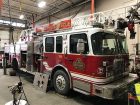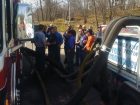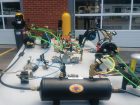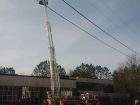
Equipment
Truck Tech: March 2019
Hello all. I want to inform you a little bit about the Emergency Vehicle Technician, or EVT program. An EVT technician is someone who performs specialized automotive work repairs on emergency vehicles.
February 15, 2019
By Chris Dennis

These consist of fire trucks, apparatus equipment, fire department automotive vehicles, ambulances, police cars and airport emergency apparatus and equipment.
Across Canada, the technician will have gone to a community college of trades to acquire the appropriate mechanic’s certificates. In Ontario, the classes are 310s automotive and 310T heavy truck. These mechanic licenses are recognized across Canada. The highest level is a Red Seal technician known as master mechanic. This licence allows the technician to work anywhere in Canada that a mechanical licence is required without further testing.
In the United States, the education typically consists of a multi-year vocational or community college program in automotive and heavy truck repair. In the U.S., an ASE (Automotive Service Excellence) certification program is also a certificate held in high esteem.
Exams offer three levels of emergency vehicle technician certification in four areas. These include fire apparatus technician, ambulance technician, airport rescue apparatus technician and law enforcement vehicle technician. Once studies are complete, exams are written in all applicable tracks and, if passed, they are supported with a certificate. The EVT certifications are voluntary unless otherwise discussed by employer.
The EVT program was first established in the U.S. in 1988. It was sponsored by the International Association of Fire Chiefs (IAFC).
The firefighter is required, through continuous education and training throughout his or her career, to stay up to date with new techniques and requirements – be it life safety or property. The IAFC decided to elevate the standards of the emergency repair mechanics who fix the rigs. The IAFC wanted to provide recognition for education and additional training performed by the emergency repair technician. The IAFC no longer oversees the emergency repair program.
The following are my views and my views only. The mechanics and repair technicians are often neglected or overlooked. We are the unsung heroes behind the scenes, the silent partner of the emergency services. We are the men and woman who keep the rigs safe and ready to respond so that firefighters and other emergency personnel can do what they have been trained to do.
This starts with decontaminating the trucks after a fire to general repair and maintenance. As I said, we, too, require continuous training and upgrading of our repair skills with the rapidly changing technology in emergency apparatus.
So, the same kind of recognition became a requirement then accepted under the National Fire Protection Association (NFPA). With this, came the EVT certification commission. This would, and has helped, with the highest standards in fire apparatus repair protocols, but only in the U.S. The emergency service has always ensured that response and rescue personnel are trained and certified to appropriate levels based on “accepted standards,” such as the NFPA standards for firefighters and fire officers.
A great deal of emphasis is placed on maintaining the condition of the apparatus and equipment used by these personnel. But what about the people who maintain and repair the vehicles and equipment? What level of training have they received to keep a sophisticated piece of machinery in proper operating order?
I can’t speak for all provinces, but I do know there are only a handful of certified EVTs across Canada. The bulk of these folks are in the eastern and western parts of Canada, with small pockets across the province. I mentioned earlier that the provincial licence that Canadian mechanics carry allows us to repair, maintain and certify any piece of equipment that our certification outlines under the Ministry of Transportation in that province.
When I first got into mechanics, I worked in small auto shops, heavy equipment shops, and body shops then settled into a heavy truck shop. My mechanic’s licence allowed me to move to these places and permitted me to work on these vehicles with the vehicle certifications I had schooled and trained for in Ontario.
The EVT program in Ontario is large in numbers. We meet once a year at the Ontario Fire College in Gravenhurst, Ont. You can find us on the web at www.evtao.ca.
On Oct. 4, 2013, the NFPA announced that Ontario would transition from the Ontario Fire Services standards to the NFPA Pro-Qualm standards in 2014. Ontario firefighters would be able to achieve National Board Services professional qualifications/certifications that meet the requirements of NFPA.
After that, many fire departments across Ontario began the transition, including Vaughan Fire Rescue Services. With this standard being an NFPA guideline, the question came up: Will the EVT component of NFPA become mandatory then at some point and time? The Emergency Vehicle Technicians Association Ontario (EVTAO) has been asking this question since the inception of the standard of October 2013. Technicians not holding EVT certificates in Ontario will be mandated, at some point and time, to begin the EVT program.
Since the mechanic licence in Ontario and Canada allows us to work on everything and anything that falls under the specific certification, do we need to follow the NFPA track for EVTs? Again, this could not be answered. It has been reported that the provincial government will be eliminating mandatory firefighting training certification regulations as per NFPA. This again brings up the question about mandatory training in the EVT program.
Let me just say this: How many times have you taken that very expensive fire truck that you painstakingly spent days and weeks designing to a specialist to meet or exceed some part of the NFPA 1901 standard? NFPA 1901 Standard for Automotive Fire Apparatus defines the requirements for new automotive fire apparatus and trailers designed to be used under emergency conditions to transport personnel and equipment and to support the suppression of fires and mitigation of other hazardous situations.
So, a rig may go to a repair shop, only to find that the mechanics working on the rig are not familiar with the fire truck, let alone how to raise a ladder or even a cab. This can hold true for both custom and commercial vehicles.
Maybe your department, be it full-time or volunteer, have heavy equipment mechanics on staff and can do the repairs in-house or in the municipal fleet garage. It could be a money-saver, but also a liability issue if a repair was not done to an engineered standard. You may take your truck to an outside repair shop. But, check to see that they hold an EVT certificate in addition to their Canadian automotive certification. NFPA 1911 is the Inspection, Maintenance, Testing, and Retirement of In-service Emergency Vehicles, and a great resource.
Most recently, across the border, the Fire Department Safety Officers Association (FDSOA) is partnering with Canadian mechanics to provide training in a joint venture in the U.S. The FDSOA supports the EVT program wholeheartedly.
Vaughan Fire Rescue Services has supported my attendance at these training conferences, as they include an apparatus symposium that is purely based on apparatus repair, safety and maintenance as the EVTAO does now in Ontario.
I have been involved in hands-on fire pump repair classes, aerial maintenance classes and had the opportunity to conduct a presentation around the F1 track of the EVT program. If you have an opportunity to send a tech to the EVTAO week in Ontario in the spring, it will be well worth it. If you are a fire chief or deputy that specifically looks after your fleet, even indirectly, you may want to attend.
If your province provides mechanical fire apparatus training shops, send everyone you can. If you want to see how the EVT track does it in the U.S. check out www.evtcc.org as well as www.fdsoa.org.
Should the NFPA standard of October 2014 be reintroduced we will be ready and hold the highest standard. It will separate the fire apparatus repair technician provincially as a special entity and a necessity to repair all fire-apparatus equipment related to our business.
By following the repair outlines and guidelines set out in the NFPA standards, our fire department rigs will be held in the highest regard and hard to challenge in the event of any issues that may arise. This will separate the standard mechanics licence, making it difficult for just anybody to correctly repair and maintain a fire fleet.
This, too, may become a standard within the bargaining units for future hires to solidify a position as apparatus repair technician. It could help to save money on new hires. The EVT certification, as well as provincial licence, could possibly be hired at a different pay scale. The internal 310T and 310s tech may want to add to their licenses by engaging in the EVT track. Again, this is only my view.
For more information on how to become a Level I, II, or Master EVT Certified Technician, go to the EVT website at www.evtcc.org.
With this ever-changing direction of the fire service and the call for transparency, I feel the public deserves the best it can get – not only from the firefighters on the front line, but the unsung heroes, the silent partners, the women and men behind the scenes that keep this equipment rolling safely and with a standard and a guideline that we all follow.
Remember, stay safe my friends and keep the rubber side down.
Chris Dennis is the chief mechanical officer for Vaughan Fire & Rescue Service in Ontario. He can be reached at Chris.Dennis@vaughan.ca.
Print this page




